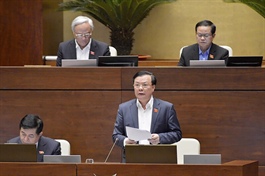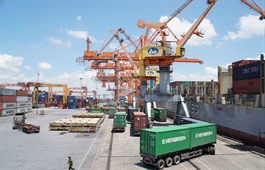What investors must notice in NPLs
What investors must notice in NPLs
Bad debts have become a common problem for the worldwide credit system. Managing partner Le Tien Dat and associate Thieu Thi Kieu Thu of APOLAT Legal write about bad debt investment in Vietnam and the factors financiers have to take into account.

Managing partner Le Tien Dat and associate Thieu Thi Kieu Thu of APOLAT Legal
|
Country definitions differ, and it is possible that what is appropriate in one country may not be so in another. However, from the point of view of the International Monetary Organization, a loan is non-performing when “payments of interest and/or principal are past due by 90 days or more; or interest payments equal to 90 days or more have been capitalised, refinanced, or delayed by agreement; or payments are less than 90 days overdue, but there are other good reasons, such as a debtor filing for bankruptcy, to doubt that payments will be made in full.”
In Vietnam, according to the State Bank of Vietnam’s (SBV) regulations, “debt” includes loans, advances, overdrafts and financial leases; discounts, rediscounts of commercial papers and other valuable papers; factoring amounts: and other forms of credit facilities. In Vietnam, the ratio of bad debts, or non-performing loans (NPLs), tended to increase from the end of 2007 and became more severe in 2011. Even as of 2015, when fully reassessing bad debt sources, the NPL ratio doubled to 17.21 per cent, equivalent to VND465 trillion ($20.2 billion) of non-recoverable loans.
Many solutions were put on the table – direct support from the government; adjusting regulations related to NPL classification and management; establishing the Asset Management Company of Vietnam Credit Institutions (VAMC); and many more. Except for the first two measures, which are applied explicitly to particular entities, the remainder are regularly adjusted and updated. There are also options that investors can consider if they want to invest in bad debt in Vietnam.
Vietnamese credit institutions
According to currently valid regulations, in addition to adjusting regulations related to classification and management of bad debts or negotiating debt settlement plans with borrowers, Vietnamese credit institutions and banks can only sell NLP balance to VAMC by special bonds issued by VAMC, or by market value. Therefore, investors will have to work directly with VAMC to buy back these debts.
However, the NPL must meet several conditions, such as bad debts and collateral must be legal with valid documents and papers; the loan customer still exists; the balance of bad loans or outstanding loan customers is not lower than the level prescribed by the SBV; among others.
In 2017, VAMC bought VND31.8 trillion ($1.38 billion) of bad debt with special bonds, VND3.1 trillion ($134.78 billion) of debt at market price, and collected just over VND30 trillion ($1.3 billion) of bad debt to sell through VAMC.
Since 2014 Vietnam has allowed foreign investors to own capital in Vietnamese credit institutions in the form of buying shares. However, up to now, the capital ownership ratio of foreign investors still occurs through several factors. Firstly, the holding of a foreign individual shall not exceed 5 per cent of the charter capital of a Vietnamese credit institution.
Secondly, the holding of a foreign organisation shall not exceed 15 per cent of the charter capital of a Vietnamese credit institution except for the strategic investor. Next, the holding of a foreign strategic investor shall not exceed 20 per cent of the charter capital of a Vietnamese credit institution. Fourthly, the holding of a foreign investor and concerned persons shall not exceed 20 per cent of the charter capital of a Vietnamese credit institution. Finally, the total shareholding level of foreign investors shall not exceed 30 per cent of the charter capital of a Vietnamese commercial bank.
Foreign credit institutions
Under the provisions of the SBV’s No.09/2015/TT-NHNN on debt purchase and sale by credit institutions and foreign bank branches, credit institutions and foreign bank branches in Vietnam are entitled to sign written agreements on the transfer of the right to claim debts arising from loan operations, whereby the debt seller transfers ownership of the debt to the purchaser and receives payment from them. This debt sale and purchase agreement must be approved by the SBV. Debts purchased and sold must meet three conditions. Firstly the dossier, related documents, and records of the debt to be purchased, and security contract (if any) provided by the debt seller must fully and accurately show the state of the debt in accordance with the law. Next, there is no written agreement on a ban on debt purchase and sale. And thirdly, the debt is not used to secure the fulfilment of a civil obligation at the time of debt purchase and sale, except the case where the secured party accepts in writing the debt sale.
In addition to buying and selling bad debts in the credit system, the Law on Securities also allows the private placement or sale of shares to swap with the issuer’s debts to the creditors. However, in order to swap shares with these debts, the issuer will have to meet the conditions of internal approval, the issuer, and more in accordance with that law.
The structure of buying debt from credit institutions still has shortcomings in practice. The government has also piloted the resale of bad debts by trading organisations and handling bad debts according to the provisions of Resolution No.42/2017/QH14 released in 2017 on pilot settlement of bad debts in credit institutions. Still, there are currently no general regulations applicable. Thus, those who want to invest in bad debt should pay attention to the purpose of buying it to choose a plan to buy and handle debt appropriately.






















